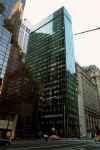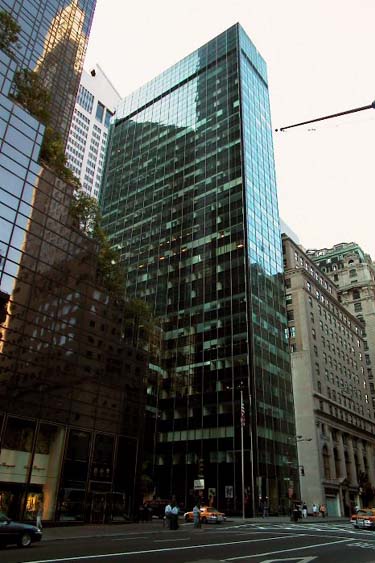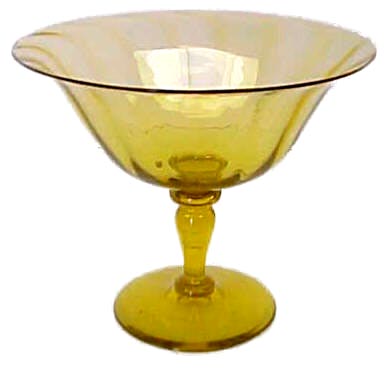 |
New York Architecture Images- Midtown THE CORNING GLASS BUILDING |
|
architect |
Harrison, Abramovitz & Abbe, Wallace K. Harrison as chief designer |
|
location |
717 Fifth Ave |
|
date |
1956-1959 |
|
style |
International Style II |
|
construction |
green glass and aluminium curtain wall |
|
type |
Office Building |
|
|
|
|
images |
 |
|
|
|
|
notes |
Also known as the Steuben Glass building, after a Corning subsidiary, was
built in 1956-1959 for the Corning Glass Co. as the first glass-walled
skyscraper on Fifth Avenue. The building replaced the Modernist, four-storey Fiberglas House (1948, Skidmore, Owings & Merrill), but it incorporated a new showroom for Fiberglas on the ground floor. The facade followed the style of the Lever Building with its green glass and aluminium curtain wall. The overall massing of the building, however, differed from its peer: the 26-storey tower is set back from 56th Street, forming a small plaza bordered by a seven-storey entrance wing. Moreover, behind the tower rises a 12-storey through-block wing. The plaza followed the lead of the new Seagram and Time-Life Buildings, albeit naturally in smaller scale, by featuring a water pool as well as seating. The entrance lobby extends through the block in the wing at the back of the plot. The 5 m high space has a decor of black Carrara glass and white marble and terrazzo. Joseph Albers provided an incised mural of geometric wireframe patterns on the white lobby wall. There is 41,800 m² of space for office and retail uses, with many prestigious outlets in the $2,000 per-sq.ft retail spaces. The building's top floor houses a 740 m² penthouse. In 2000, Steuben Glass vacated the building for 667 Madison Avenue, after 40 years of occupation. Two years later, Walton Street Capital bought the building for $266 million, one of the highest per-sq.ft prices at $611 |
Transformed by Modernism & Depression    Many people are familiar with the water-clear, sleekly designed leaded crystal forms produced by Steuben today. While their modern glass is art in itself, the production of Steuben glass in the Art Nouveau and Deco eras was remarkably different. Interestingly, Frederic Carder, the man behind the company, loathed the modernistic clear crystal, as he was an ardent lover of colored glass. Steuben production began in Steuben County, within the city of Corning, New York c.1903, and was under the control of Carder until 1918 when he sold the company to Corning Glass Works. He maintained the post of manager until 1932, and in fact lived until 1963. The English-born Carder was a gifted artist and draftsman, and out of his sketches came fabulously colorful glass: perfumes, vases, figurines, tableware and more. It is difficult to discuss Steuben glass from the turn of the century to the ‘30s without a comparison to the production of Louis Comfort Tiffany. Tiffany Studios’ glass tended to be t more strictly Art Nouveau and fluid in design, while Steuben’s often had more of a classical and structured feel to it. Although the design ethic does overlap in places, particularly in the range of color produced, with similar gorgeous iridized colors applied to glass. In fact, in 1913, Tiffany sued Carder for making a similar product, though the suit was later dropped because Tiffany Studios didn’t follow it up in time. Amusingly, the two men got along when they met in later years. Steuben’s iridized colors in gold and blue were known as Aurene. It is currently somewhat easier and more affordable to obtain a lovely example of Steuben than L.C. Tiffany glass. Steuben was frequently made in gorgeous bright colors, opaque and translucent alike. Translucent colors inclued Amethyst, clear iridescent Verre de Soie, medium but vivid Celeste Blue, darker cobalt Flemish Blue, among others. Some of the opaque colors were Alabaster, Mirror Black, iridized white Calcite (which can often be found as a lining in some Gold Aurene pieces), Green Jade, Light Blue Jade, and many others. Besides the lovely iridescent opaque metallic finish of Aurene, there were many other equally stunning (and harder to find today) lines produced by Steuben. Cluthra is one of the most visually interesting. The glass is a thin, cased milky glass with blotches of opacity, with rows of bubbles within it, and usually with a color included. The effect is difficult to describe, but it has a hightly distictive appearance, reminiscent of thin striated clouds in the stratosphere. Other lines were: Cintra, similar to Cluthra; Intarsia, with colored flowers within the glass; and Silverina, with square airbubbles cased within… and many more. Also difficult to obtain are the figurines, primarily produced in clear leaded glass, or cire-perdue glass (a one-off technique involving a wax cast that melts and is “lost”). Classically Art Deco gazelles in motion, elephants, figurines, and geese are some motifs found. The gazelle and elephants are from molds, but still rare; the one of a kind cire-perdue items are mostly in museums. Not all Steuben is signed- most of it is, however. The signatures found on Aurene and most pre 1932 pieces are hand-engraved on the bottom, sometimes with a shape number included. Later, an acid etched fleur-de-lis with the word Steuben was employed. Some early pieces are signed Carder and Steuben both. There are other variations of signatures, but those are the most commonly seen ones. Carder through Steuben, like Tiffany, also produced architectural glass. The Corning Glass Works building once featured lovely mosaics made of Steuben Aurene glass- sadly, like many architectural Tiffany works as well, the building was demolished. In 1932, Corning Glass, the parent company was fed up with the Steuben division. It was not turning profit, and they felt that having one man, Carder, in charge of basically everything was an anachronism. The decision was made to forcibly “promote” Carder out of control of Steuben, and to phase out colored glass, replaced by a new modern variety of water clear, high lead content “optical” crystal. In fact, the transition was literally violent; th enew management held a “smashing” of much of the leftover Carder designed stock, which left Carder heartbroken (and many collectors today as well, no doubt). The next day he quietly molded a cire-perdue head of Christ to express his feelings of martyrdom. Thus ended an era. The legacy of Carder’s artistic vision, executed in an exquisite rainbow of Steuben glass, lives on today in many lucky collector’s displays. Steuben’s glass is truly exemplary of the Art Nouveau and Art Deco movements, and as such, it disappears rapidly when it becomes available.
|
|